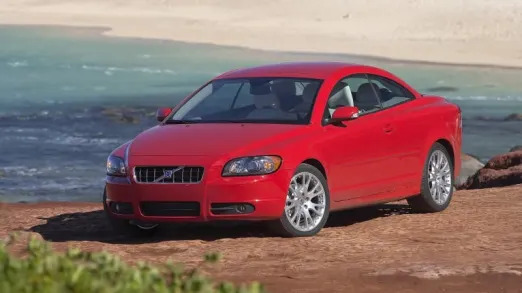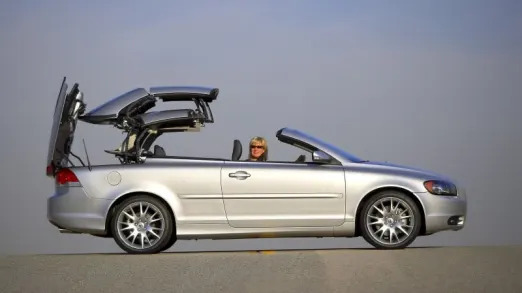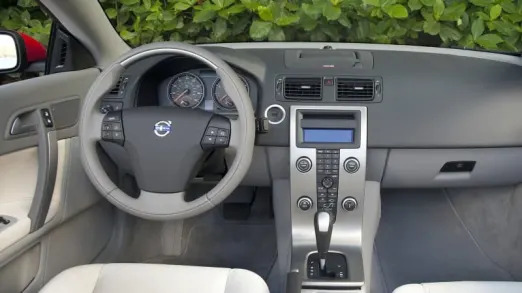In the customary Scandinavian fashion, form and function often exist on the same plane. For example, take the cushy recliner that offers superb comfort as well as a sleek, modern profile. Or the Nordic minimalism of a pure wood dining table that seats eight. Or the Volvo C70.
The luscious, feminine lines of the Volvo, designed with help from Ian Callum, famous for his designs for Jaguar and Aston, complemented rather than disrupted its breakthrough feature for the second generation C70: a self-storing hardtop that turned the machine into a “coupe cabriolet.”
The C70 launched in 1996 at the Paris Auto Show, and from the get-go, it changed — actually, it annihilated — Volvo's decades-long styling tradition of boxy, rectilinear designs. According to Peter Horbury, Volvo's design chief from 1991 to 2002, with the C70, Volvo threw away the box, but "kept the toy inside. Our vision was to design a convertible that would meet the needs of a family of four looking for comfortable blue-sky motoring in a vehicle also providing stylish looks, performance and faultless driving and road-holding.”
Apparently the idea was not to reinvent the Swedes’ glorious P1800S sports coupe from the Sixties, but, as Horbury said, to throw away the box. And create a comfortable, stylish, adequately powered boulevard cruiser.
To challenge their competitors — the targets included the BMW 3 Series (don’t they always?) and Mercedes CLK — Volvo’s engineers did their homework, auditioning the Germans on European roads.
The C70’s development, undertaken jointly by Volvo and by Oxford-based touring car specialist Tom Walkinshaw Racing (TWR), was rocky and was dissolved prior to the car’s launch. But TWR’s design and suspension work proved useful. And Volvo’s contributions in design were stirling.
Why is the Volvo C70 a Future Classic?
The mission statement for the C70 from the outset was to fashion a true convertible, a two-door, luxury sports car that combined performance and a high level of equipment with the Volvo’s reputation for safety. The mission was accomplished.
We’ve already talked about design and chassis development. Regarding performance … well, you could’ve had your choice, as long as it was the reliable T5, a five-cylinder, 2.3 liter turbocharged motor that is some applications made 240 horsepower and 240 Ib-ft of torque. In some markets, the car was offered with other engine configurations, with horsepower that ranged from 170 to 245.
What is the ideal example of the Volvo C70?
Volvo took pains to make the C70 special from the beginning. Seventeen different exterior colors were developed under the supervision of designer José Diaz de la Vega (fans of the C70 may recall that a Garnet Red version was driven by Val Kilmer in the film versions of “The Saint”). The C70 also played a terrific audio setup for its time: loudspeakers from the Danish prestige brand Dynaudio, Dolby Surround and an amplifier with up to 400 watts.
In 1997, Volvo’s first production convertible was added to the coupe and it soon stole the limelight. Volvo even quit making the coupé by 2002 to focus on the convertible only for another three years.


The second generation C70, complete with its fashionable folding metal roof designed by Pinanfarina, was revealed in Frankfurt in 2005 and from 2006 to 2013 — when C70 production ceased — replaced both the convertible and the coupé. The retractable hardtop went on sale in the U.S. in spring, 2006.
The three-section hardtop assembly itself is worth a separate story. Manufactured by Pininfarina in Uddevalla, it rose or retracted in less than 30 seconds and includes a “global” switch that allows simultaneous raising or lowering of all windows, and a button to power-activate the raising of the folded top stack within the trunk — specifically to increase access to cargo storage.
The C70’s sex appeal and celebrity roof didn’t do much to impress Geely, Volvo’s new Chinese owners. Their priorities involved building a brand focused on sedans and crossovers. After a total production run of both generations of the car of about 160,000 units, it was time to bid adieu to this funky, formidable “toy” in 2013.
Be sure to check out our used vehicle listings; they can be helpful for finding a good deal. You can narrow the options down by a radius around your ZIP code, and be sure to pay attention to the deal rating on each listing to see how a vehicle compares with others in a similar area.


Are there any good alternatives to the Volvo C70?
When Volvo launched the C70 it Paris, it joined a new crop of big 2-to-3-litre European coupés was on its way. The late Nineties brought forth the likes of the Peugeot 406 Coupé, the Mercedes-Benz CLK, and the BMW 3 Series, all sleek products of their design era.
From American and Japan, buyers can contemplate the Infiniti G37 Convertible, with a more powerful 325-horsepower 3.7-liter V-6 engine, and an available six-speed manual transmission. The Ford Mustang shares some of the extrovert sensibilities of the C70, although lacks the refinement and the Volvo cache.
For those who’ve got a hankering for a retractable hardtop, consider the Volkswagen Eos, which was a perfectly competent substitute for the Volvo, although its agility was hampered by its awkward weight distribution.


Sign in to post
Please sign in to leave a comment.
Continue